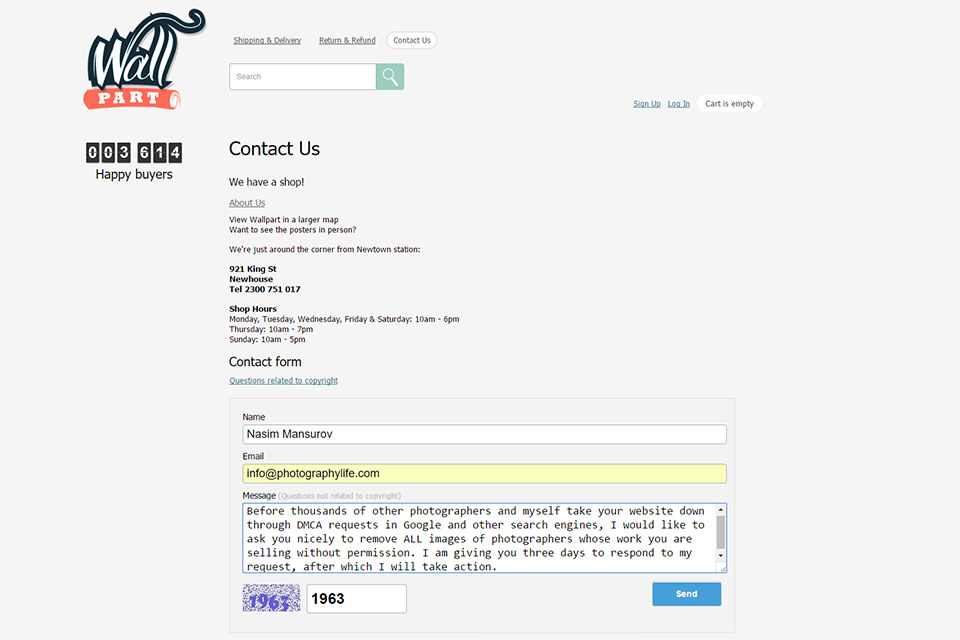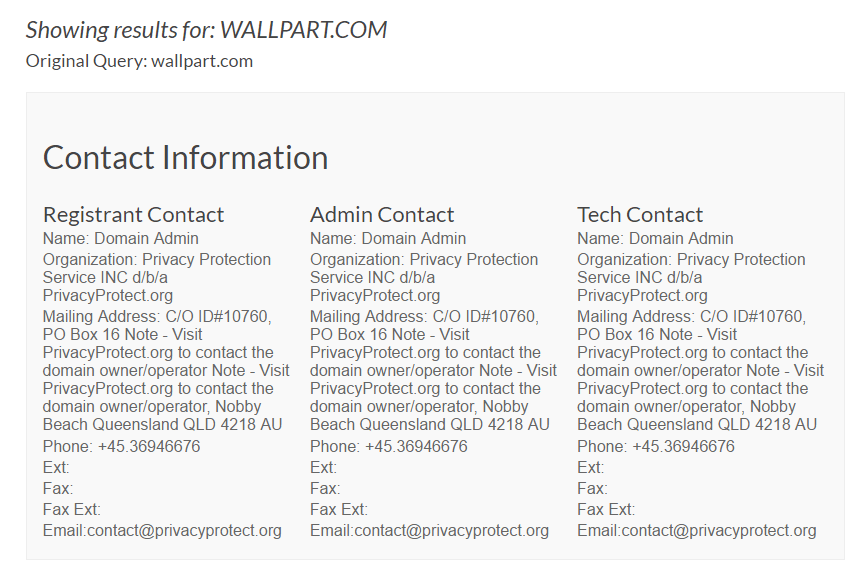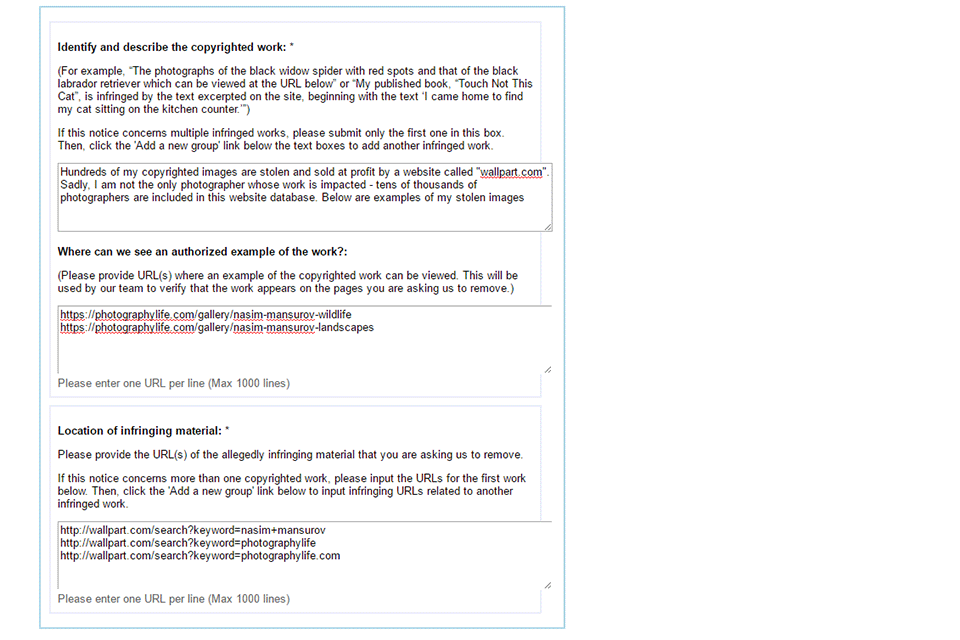If I were to tell you that there is a website out there that steals photos you post on the Internet and sells them without your permission, how would you react? I bet you would not be happy. Earlier this week, our very own Thomas Stirr reached out to me, asking what I would do with a website called “WallPart.com” that sells posters of my photographs. At first, I didn’t think it would be bad, since my photos get taken without permission all the time and they often end up being on some unknown sites (mostly outside of the USA). But this one did tick me off a bit more than usual, since not only did it contain a boatload of my images sold at a ridiculous price of $ 5.59 for a 6×4 print, but it also contained images of pretty much every photographer I typed into the search field. And based on the Alexa rank of the website, the site has been growing at an incredibly fast rate, with close to 60% of hits coming from search engines. That’s pretty alarming, given that the majority of people ending up on the website are coming from the USA. So if you have been posting your work online, it is either already on this website, or fairly soon it will end up there. So what should you and I do about these thieves?
As I have said, this is not the first time I have encountered theft of my work. Image theft happens all the time on the Internet and unfortunately, many people out there make an assumption that if an image is posted online, it must be OK to use without permission. I remember a recent case that happened to my wife Lola – her photographs of food were stolen by a few restaurants, who used her photos on their websites, on their menus and on their walls. She was contacted by her friend, who visited one of such restaurants and saw a very familiar image that she immediately recognized. After Lola contacted the restaurant and asked to remove her images, she received a very angry email in return, which instead of apologizing to Lola had a few attacks including cuss words. She was completely shocked to read that email. Litigation was not an option without incurring heavy costs, since the restaurant was located in a different country. In another case, a restaurant owner responded by saying that Lola should be honored for the restaurant to choose her photographs instead of many others they could “feature”. As for me, I could tell you many more stories like this that happened to me over the years. Some involve blatant image theft as above and others even had the guts to fully copy the content of this website, translate them to other languages and republish without permission.
While taking action for some people might not be necessary, for others it can translate to loss of business. For example, I personally gave the sensor cleaning product we sell right here at PL “sensor gel stick” and yet after a few years of selling the product, someone registered a domain called “sensorgelstick.com” to sell the product via Amazon to generate money through affiliate links. Although I have warned people not to buy the fake copy from Amazon (it is shipped from a company in China), people continue to do so, with some ending up with their AA filters getting ripped out of their expensive Nikon D5 cameras. This obviously caused quite a bit of loss of business and reputation to me and the company I represent, and despite my efforts to close the website down or reach out to Amazon, I have not had much success in resolving the issues with such third party resellers and abusers. However, there have been cases where I have been successful in getting my work taken off certain websites, sometimes through friendly email exchanges with the individuals or companies, and other times through DMCA takedown requests (more on the process below).
How to Deal With Image Theft
While litigation often seems like a good idea to deal with online theft, it is often a real pain to go through, especially for those who aren’t already familiar with the process. Finding and hiring a lawyer isn’t cheap and paying someone for something that might not yield anything at the end can be quite frustrating. Some people end up losing a lot of time and money, only to discover that the company they sued either went out of business, or can only pay for the photograph that was misused, without taking care of attorney fees.
Option One: Contact the Company / Individual / Webmaster First
Sometimes, instead of dealing with litigation directly, it is better to involve the website owners and then search engines to deal with theft. A website that stole your image(s) will typically have some sort of contact information that you can use to reach out. In the case of WallPart.com, the website does have a “Contact Us” page from which you can supposedly reach out to the website owners. First, I am going to reach out to the website owner and ask them nicely to remove not only my images, but all other images that were taken without permission:

My recommendation would be to first wait for a response. However, in the case of WallPart.com, the immediate response I got after typing the above was “wallpart.com is currently unable to handle this request, HTTP ERROR 500”. So the contact form does not work, which leaves me with another option – to look up the contact info from the domain whois database. So whenever you cannot find any contact info, looking up the owner of the domain can be a good alternative. Let’s take a look at what we get:

Clearly, this website does not want anyone contacting them. I am not going to contact the website through “PrivacyProtect.org” or their email contact@privacyprotect.org. So this leaves me with the last option, which is to create a DMCA takedown request. If such a request is approved by the search engine, the website in question might get severely penalized by the search engine and possibly even removed from the search engine completely, which will seriously hurt the company and hopefully teach them a lesson. This is especially bad for websites that rely on search engine traffic.
Option Two: Use DMCA Takedown Request
The way DMCA takedown requests work, is you initiate a request through a search engine, which in this case I am going to use Google. If you visit this page at Google, you will see quite a bit of information regarding legal removal requests. Once you go through all the information, you will eventually end up on this page, which is specifically created for such takedown requests.
What you do from here, is fill out all the information and submit it. Then you wait for Google to take action. Within a few weeks, you should have a decision from Google on your request. Here is part of the form that I filled out:

If your images are featured on a website like above, make sure that you fill out the form properly and provide all the requested information for Google and other search engines to be able to help you out. Bing, Yahoo and other search engines do have similar forms, so make sure to fill those out as well!
Option Three: Litigation
If the two steps above fail and you got nowhere, perhaps it might be time to consider litigation. There are very rare cases where you actually want to pursue litigation as the first option. For example, if a large company stole your image and used it in a large advertising campaign, I would not contact the company or deal with DMCA takedown requests at all – I would immediately hire a good lawyer. If it is a large company with a lot of funds, you will get paid for damage and most likely recover all of your litigation costs. However, if you are dealing with a shady individual or a small company, you are almost always better off pursuing options #1 and #2.
In the case of WallPart.com, I will use option #2, since option #1 already failed. We will see what Google says after a few weeks…
If you are going to take similar action, please report your success or failure on the discussion form below – I would love to find out how well such DMCA notices work. I have both succeeded and failed to take sites off search engines in the past, so I can only report partial success. Hopefully with a group effort, we can take such sites down and teach them all a big lesson!
The post How to Deal with Online Image Theft appeared first on Photography Life.







